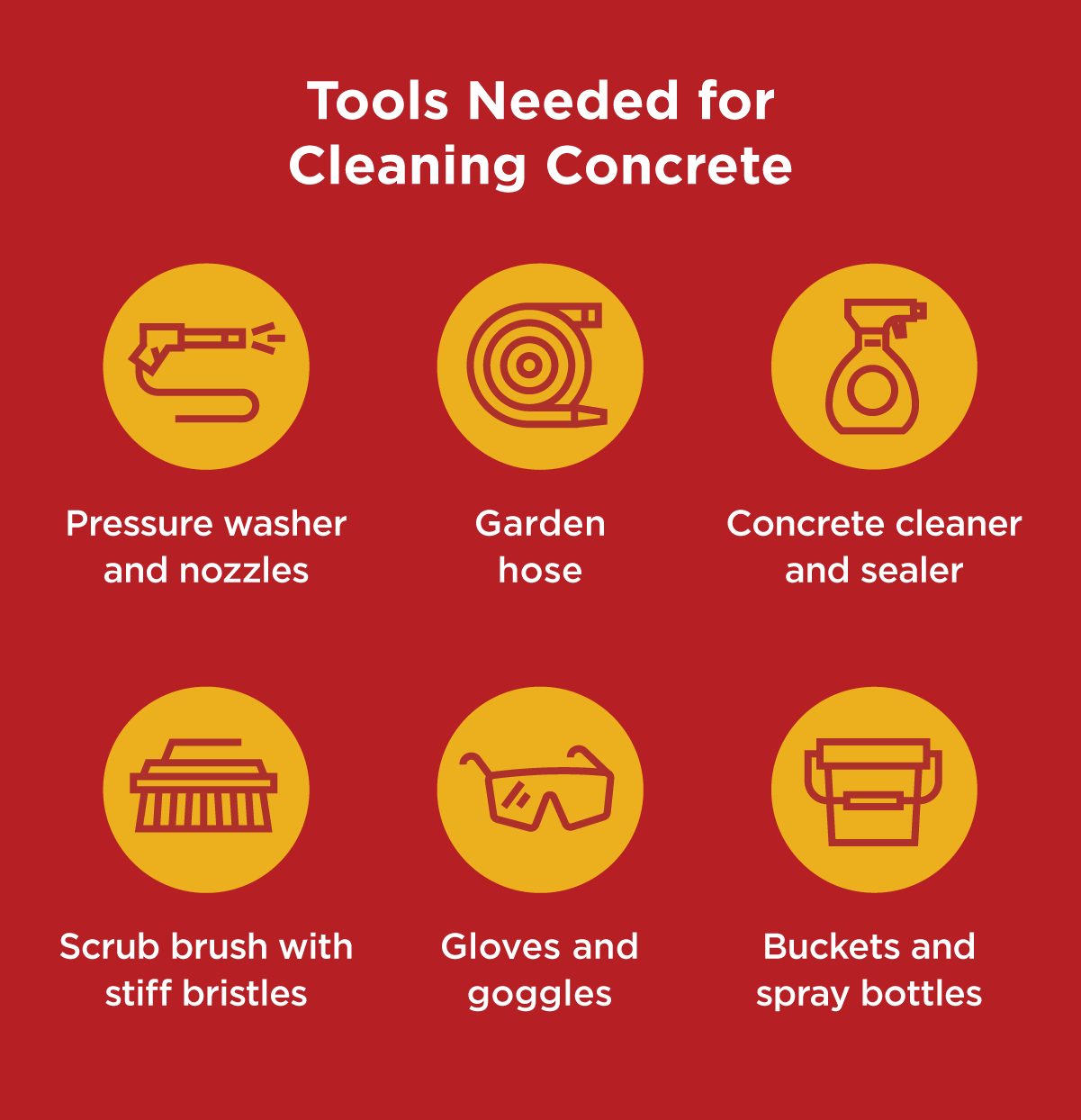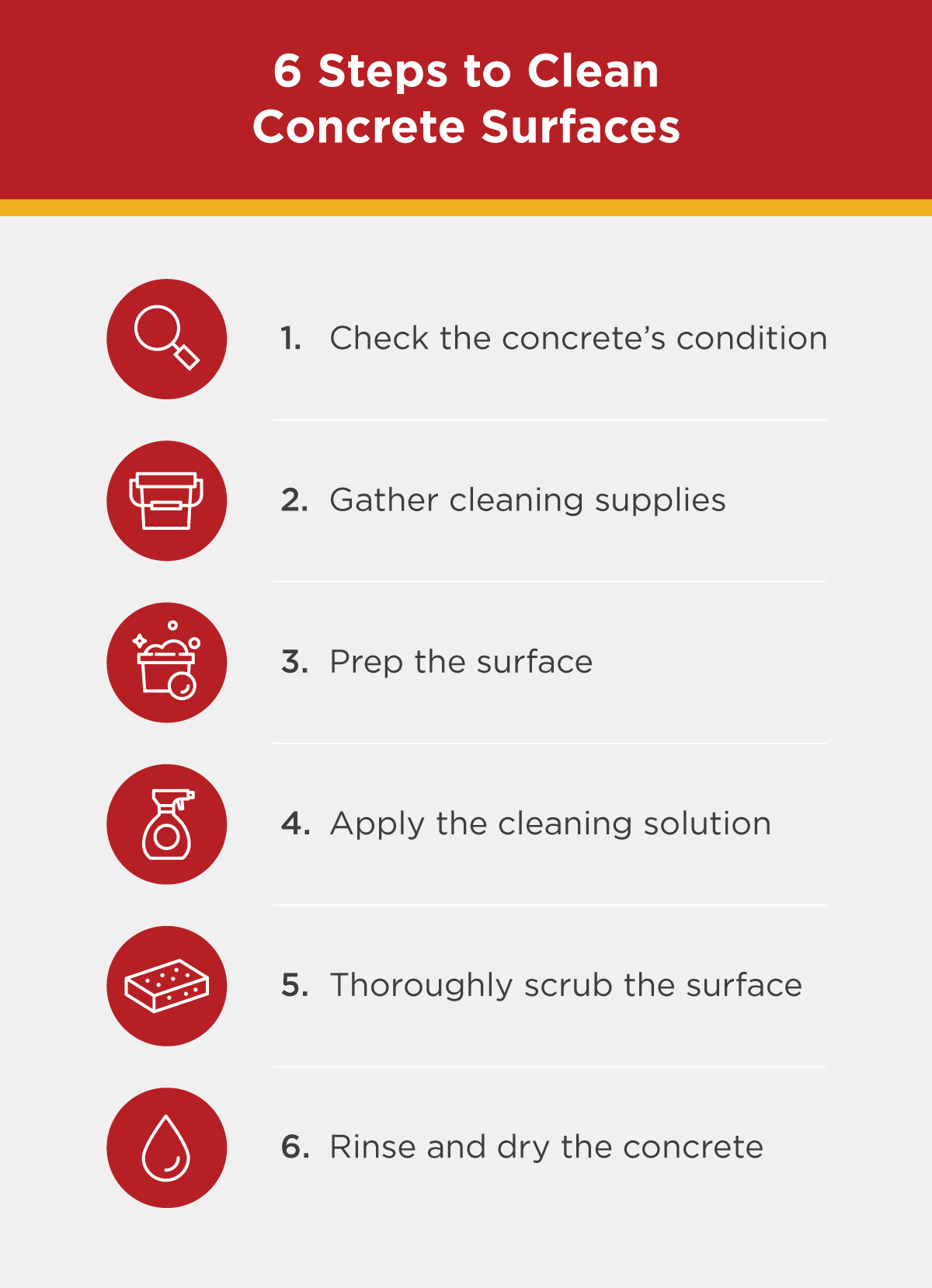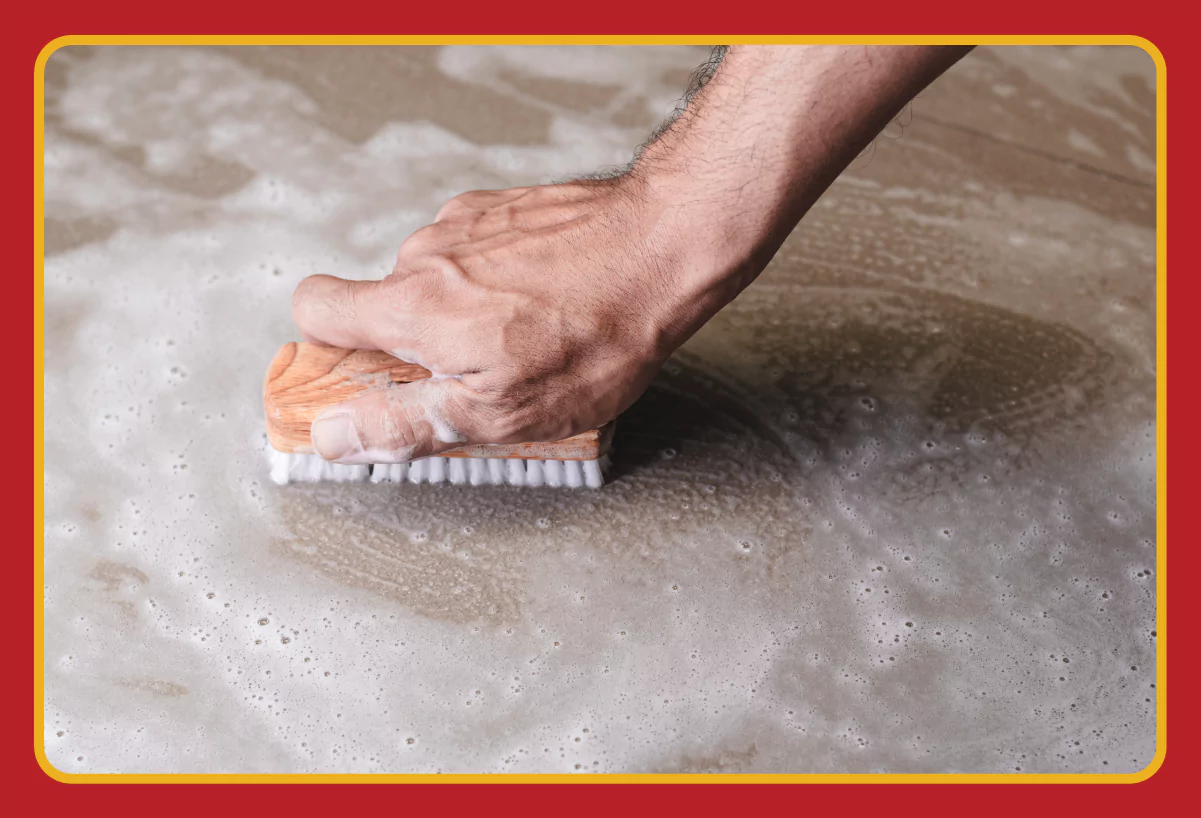How To Clean Concrete in 6 Steps
|
Quick answer: In this guide, you’ll learn the process for cleaning concrete:
|
It’s easy to assume that concrete doesn’t need a lot of TLC to keep it in good shape. After all, it’s made out of rocks! But concrete has to be maintained. If it isn’t, minerals, debris, plant matter, and dirt can take a toll. They can erode, stain, and even crack. Taking care of your concrete surfaces can help them look better and last longer. Learning how to clean concrete is relatively easy.
This guide from the team at Mr. Handyman® will show you six easy steps to help you clean your sidewalks, patios, driveway, and other concrete surfaces. With a few supplies, some elbow grease, and time, your concrete will look great again.
Step 1. Assess Your Concrete’s Condition
Before you clean your concrete driveway, patio, or floor, you’ll need to figure out what the issue is. Many concrete stains are caused by dirt or plant matter, which are usually near the surface and are cosmetic only.
On the other hand, oil, grease, moss, and rust stains are usually deeper and might be accompanied by physical damage to your concrete. If your concrete is chipped or has chunks missing, be careful about applying too much pressure or using certain kinds of cleaners, like bleach. They could make the damage worse.
If you aren’t sure how deep a stain is, sweep the area, then press a paper towel onto the stain. If there’s nothing on the towel when you lift it up, the stain will probably take a little extra work to get out. If oil or grease is on the towel, try to dab as much of it up as you can before getting it wet.
Inspecting and cleaning your concrete before you begin new deck or patio construction can help you avoid a lot of headaches, expenses, and wasted time.
Step 2. Gather Supplies
After you’ve assessed your concrete and decided that cleaning won’t damage it, get your supplies together. Prepping your materials before you start will make the process a lot faster.
For dirt and light stains, water and dish soap is usually good enough. If you have dark stains like rust or oil, pick a concrete cleaner that’s made to take care of those specific stains.
A stiff-bristled brush will help get rid of built-up dirt and debris and, when paired with the right cleaning solutions, can even remove oil, grease, and rust. A pressure washer can also help remove a lot of surface stains.
Protective gear is a must when working with a pressure washer or chemical cleaners. Thick gloves, eye protection, and long sleeves and pants can help keep chemicals off your skin and protect you from any flying debris.

Step 3. Prepare the Surface
With all of your supplies ready, you’ll want to start by preparing the surface. The first step is to remove any debris. Sweep up leaves, dirt, grass, dust, rocks, and any other loose materials to keep your work area clear of obstructions.
Once you’ve swept the concrete, get it wet. Spraying the concrete with water before adding the cleaning solution will help it absorb the cleaner. This is especially important if there are deep stains, moss, or oil you’re trying to remove.
If you’re cleaning on a hot day, you can spray one section of your concrete at a time to keep it from drying before you apply your cleaner.
Step 4. Apply the Cleaning Solution
After you’ve sprayed down the concrete, dilute your concrete cleaning solution with water according to the manufacturer’s directions. It’s best to do this in a bucket or a spray bottle to reduce spills.
Dip your brush into the bucket and evenly spread the cleaning solution across the concrete. If you’re using a spray bottle, spray the concrete until there’s an even coating.
Don’t worry about scrubbing just yet. Depending on what you’re using and what you’re trying to clean, you may need to let the solution sit for a few minutes to penetrate the surface.
Step 5. Scrub the Surface
After spreading the cleaning solution across the concrete (and letting it sit if necessary), use the stiff-bristled brush to scrub away stains, moss, and dirt. Most stains and dirt should come up pretty quickly, but more stubborn stains might require extra work.
Spray the surface with a hose or pressure washer to check your progress. If needed, add some more cleaner, let it soak in for a few minutes, then scrub and rinse until the stains are gone.
For the deepest stains, you may need to try a different type of cleaning solution. Try looking for cleaners that are made specifically for those types of stains (oil, grease, rust, etc.).
Step 6. Rinse Thoroughly and Allow To Dry
Once all of the stains are gone, use a hose or pressure washer to rinse the concrete until the water runs clear. That means that the last bits of dirt and cleaning solution are gone.
If you’re going to use a sealer or another type of coating on your newly cleaned concrete, make sure the surface is completely dry before you apply it. If your concrete is still wet, the sealant may not adhere correctly.
When cleaning cement countertops, dry around the kitchen sink as well as possible, especially if you’re caulking.

How To Clean Concrete Without a Pressure Washer
Using a pressure washer to clean your concrete will make the job go quickly, but that doesn’t mean you can’t get the same results with a hose and a little more time and effort. Prep the area by sweeping up any debris and dirt, then wet the concrete with a bucket of water or a hose.
A regular garden hose with a sprayer attachment (like the kind you’d use to wash your car) can rinse off most surface-level dirt and stains.
If you have a small stain on your concrete and don’t want to use a pressure washer, you can create a paste using 1/2 cup of baking soda, 1 gallon of water, and a generous squirt of dish soap.
- Mix the ingredients together and then smear the paste on the stain.
- Let it sit for 30 minutes
- Scrub the area with a coarse brush.
- Rinse off the paste with a hose and repeat until the stain is gone.
If the baking soda paste doesn’t work, you can also try using a vinegar and water solution:
- In a spray bottle or bucket, combine equal parts white vinegar and water.
- Spray or soak the stain with the mixture and let it work into the concrete for a few minutes.
- Dip a coarse brush in the mix and vigorously scrub the stain.
- Rinse with water and keep working at the stain until it lifts.
But be careful—while vinegar and water can remove rust stains from concrete, it could cause etching and darkening. Try the solution on a small area (like on the edge of the slab or an area usually covered by a grill or flower pot) to see what it does to your concrete.
If you’re trying to clean indoor concrete floors or countertops, proceed with caution.
Tips for Cleaning Concrete
Cleaning concrete can be a tough job. Follow these tips on how to clean cement and concrete more easily:
- Clean up spills ASAP: The best way to remove concrete stains is to prevent them from setting in. Quickly clean up oil and grease spills and keep your concrete swept and free of dirt and debris, which also improves home accessibility.
- Check your pressure washer’s PSI: Anything under 1,500 PSI could make for slow work, while settings over 3,000 PSI could damage your concrete.
- Look for spalling and cracks before you start cleaning: While cleaning damaged areas by hand likely won’t worsen the damage, using a pressure washer on broken concrete could cause expensive problems.
- Avoid metal brushes: Metal bristles can get embedded in your concrete and lead to rust stains.
- Don’t forget the less obvious concrete: Concrete footings, retaining walls, and steps need regular maintenance and cleaning, too.
- Know when to call in a professional: DIYing concrete cleaning can be tough. Professional home repair service professionals have the tools, cleaners, and experience to get better results faster.
No matter what kind of concrete you have, maintaining it is always easier than performing a deep clean. This is especially true when you have sealed, polished, or painted concrete floors.
How To Maintain Concrete Floors
The concrete used for kitchen flooring is basically the same as concrete used outdoors, except interior concrete is usually polished and sealed. Polished, sealed concrete is extremely tough and much less likely to stain than untreated concrete, but it still needs to be properly maintained.
The best way to maintain concrete floors is to follow a cleaning routine. Clean up any spills as quickly as possible and sweep and mop concrete floors regularly. Luckily, resealing is only necessary every two to five years. If you have a lot of traffic on your concrete floors, you may need to seal them more frequently.
If your concrete floors are painted, follow the cleaning and maintenance recommendations from the paint’s manufacturer. You may need to clean more often to keep the paint looking clean.

Contact Mr. Handyman for Concrete Cleaning Help
While anyone with some basic tools and time on their hands can learn how to clean concrete, it’s never a bad idea to have professionals handle the work. Along with using the right equipment, professionals have experience with various masonry and concrete services that leads to better results and reduces the likelihood of further damage to your concrete surfaces.
Whether you want to add a flair to your concrete or you need to make an old, stained patio look brand new again, Mr. Handyman offers the local exterior cleaning services you can trust to get the job done right.
This article is intended for general informational purposes only and may not be applicable to every situation. You are responsible for determining the proper course of action for your home and property. Mr. Handyman is not responsible for any damages that occur as a result of this blog content or your actions. For the most accurate guidance, contact your local Mr. Handyman location for a comprehensive, on-site assessment.
How To Clean Concrete FAQs
Mr. Handyman has been helping homeowners repair, maintain, and enhance their spaces for over 25 years! We are the one-stop solution for everything on your to-do list. This includes answering your questions about home repairs, maintenance, and improvements. Here are answers to some of your most frequently asked questions about how to clean concrete.
How often do you need to seal concrete floors?
You only need to reseal most concrete floors once every two to five years. For retail locations or warehouses, you may need to reseal concrete floors more often, depending on traffic.
How much PSI is needed to clean concrete?
To clean concrete efficiently, you’ll need a pressure washer with anywhere from 2,500 to 3,000 PSI. 1,500 PSI will work, but it can take longer. Higher pressures could damage your concrete.
What is the best way to clean a concrete patio?
The best way to clean a concrete patio is to keep it free of debris by regularly sweeping plant matter and dirt off of it as soon as you notice it. To deep clean a patio, you can wet it down, scrub it with a stiff brush (or spray it with a pressure washer) and some concrete cleaner, and then rinse it thoroughly.
How do you make dirty concrete look new?
To make dirty concrete look new, start by sweeping all of the dirt and debris off of it. If it still looks dirty, get the concrete wet, then apply a concrete cleaning solution before spraying it with a pressure washer or scrubbing it with a stiff-bristled brush. Rinse well, then repeat on any areas that still look dirty. If there are oil or rust stains, use a cleaner designed to remove those stains.
 Click to call
Click to call


